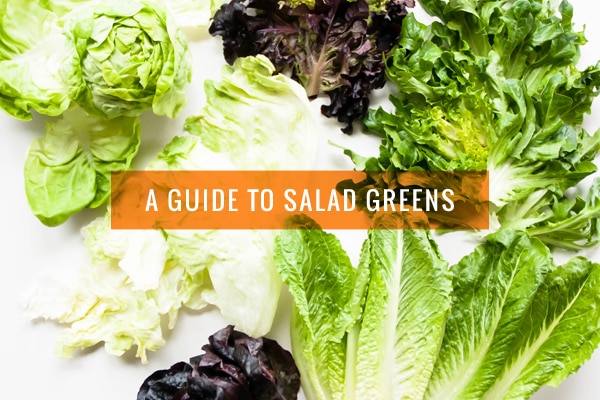 Photos by Lindsey Johnson
Photos by Lindsey Johnson
We've all seen the photos of the quintessential "woman laughing alone with salad." It's funny and cliched, but it's kind of true too. You can't help but feel great when you're eating a big, healthy, vibrant green salad. Salads are an easy way to work in your daily veggies without loading up on the calories--well, as long as you choose your toppings and dressing carefully, of course.
Salad greens are a great source of vitamins, especially A, C, and K. Many are high in iron, some even have surprising amounts of calcium. Add that in with the fact that many of them contain disease-fighting phytonutrients, and it's hard to find a reason not to go for leafy greens whenever you can.
Oh, and a perfectly constructed salad just tastes darn incredible too.
Here's a guide to salad greens, which includes details about different varieties of greens as well as information about selecting, storing, and serving. Now you'll have no reason not to grab a salad and laugh alone while eating it. Who's going to have the last laugh now?!
How do you choose the best salad greens?
It's generally pretty easy to tell fresh greens from those that are past their prime. Salad greens should be vibrant and crisp--avoid signs of wilting, yellowing or brown spots. Head varieties should be tightly furled, not loose or limp.
How do you store salad greens?
It depends on the green, but for most lettuces, simply wrap the bunch with paper towels or a damp kitchen towel, then place them in an unsealed bag and refrigerate. Keep loose leaves like baby spinach, watercress, and arugula in a more tightly-sealed plastic bag. Most should keep nicely for 3-4 days.
Kale can be stored in a loose bag without wrapping, but keep it in the coldest part of your fridge--and use it as soon as you can after buying it. It can become unpleasantly bitter if stored for too long.
Quick tip for gardeners: If you grow your own greens and find the leaves are a bit limp after plucking them out of your garden, try laying the freshly-washed leaves on a layer of damp paper towels, rolling them up, placing them in an unsealed plastic bag, and storing them in the fridge for a few hours. You'll be surprised at how well they can crisp up!
Why should you eat salad greens?
They’re incredibly good for you! As a general rule, the darker the green, the more nutrient-dense it is. Intensely hued greens like kale and spinach contain huge amounts of vitamins such as A, C, iron, and calcium--and have found their rightful place on "superfoods" lists everywhere. On the other hand, paler-leaved bunches like iceberg lettuce or endive rank lower on the nutritional scale. But they’re still low-cal, high-fiber, and generally very hydrating.
All in all, no matter the green, it’s hard to go wrong!
How do you prepare salad greens?
It depends on the variety, but one universal tip is to dry, dry, dry! Making sure the greens are bone-dry after washing them helps the dressing cling to the leaves and reduces the risk of a soggy salad. Nobody wants that! You can use a salad spinner, or my favorite method: throw them in a clean plastic bag with several paper towels, and whip that bag around in a super-fast circle for 30 seconds or so. Just make sure there's no one close by (ouch) and the bag doesn't have any holes in it (mess).
A balance of flavors and textures makes for the best salads. We like to top our salad greens with something sweet (like fruit), something crunchy (like nuts), something pungent or salty (like cheese), and then use a nice, light dressing flavored with fresh herbs (like vinaigrette). To make it a meal, we'll increase the nuts or cheese for added protein, or include protein-rich mix-ins like baked tofu, hard-boiled eggs, or quinoa.
What kinds of salad greens are there?
So many we could never count them all! Here are some of the most popular:
Lettuces
The most well-known of salad greens, lettuce is renowned for its mild, sometimes even sweet flavor that goes well with just about anything. Lettuce grows in all shapes and sizes, but generally falls into one of two categories: head lettuce or loose-leaf lettuce.
Head lettuce grows in a tight ball, whereas loose-leaf lettuce grows in, well, looser bunches. It's also one of the most popular veggies to grow in home gardens, so if you decide to grow it, you may want to go the loose-leaf route--instead of needing to harvest the entire head of lettuce at once, you can just grab a few leaves here and there as needed.
You already know lettuce is low-calorie (clocking in at right around 10 calories per cup), but it's solid nutrition-wise, too. Most varieties of lettuce are especially good sources of vitamin A and potassium. So eat up!
Some of the more well-known varieties of lettuce are:
Butter lettuce // This yellow-green head lettuce boasts an almost creamy--and yes, buttery--texture. Usually sold in small-to-medium heads, butter lettuce's diminutive size and wonderful texture makes it the perfect topper for burgers or sandwiches. Popular varieties include Bibb, Boston and red butter lettuce.
Recipe to try: Boston Lettuce Salad with Herbs & Toasted Almonds
Iceberg // Iceberg lettuce gets a bum rap--and sure, it's not the most nutritious of salad greens. But it's got its place! The tightly packed leaves on dense, heavy heads contain more water than most, making it an excellent choice if you're looking for foods that hydrate. Cut this neutral-tasting head lettuce into wedges or thick slices for a popular wedge-type salad, or slice it into strands and throw it in with other greens to add a bit of crunch.
Recipe to try: Spring Wedge Salad
Leaf lettuce // Leaf lettuce is also sometimes called loose leaf, or it's often named by its color--green leaf or red leaf. No matter what you call it, this mild lettuce with large, frilly-edged leaves, is one of the most familiar. Its mildly sweet, delicate taste and nice, crisp bite make it the perfect lettuce for sandwiches and burgers. It's also a popular lining for hors d'oeuvres platters--and while it's pretty, we've got to admit that it's tough to see such a great green go to waste!
Recipe to try: Autumn Salad
Oak leaf // Oak leaf lettuce is visually very similar to leaf lettuce, but with more of an oak leaf shape. If you prefer to steer clear of bitter greens, this super-mellow, sweet lettuce is for you. Red oak leaf lettuce, with its frilly edges and reddish-purple hue, is a particularly nice choice if you're looking to pretty-up your plate.
Recipe to try: Oak Leaf Lettuce Salad with Cabrales & Red Grapes
Romaine // Arguably the king of salad greens (and certainly one of the most popular), romaine boasts a light, almost grassy taste and a satisfying crunch. It's THE green for Caesar salads and the perfect wrapper for all kinds of delicious fillings. The crunchy rib can sometimes sport a bitter aftertaste, so cut the ribs out if you don't like them. Romaine isn't just delicious, it's also particularly rich in folic acid and vitamin K.
Recipes to try: Classic Vegan Caesar with Avocado & Chickpeas or Chili Salad Wraps
Chicory family
Very closely related to lettuce, chicory tends to have a more bitter, in-your-face taste in comparison to its milder brethren.
Chicories can be a confusing bunch--depending on your region, any of its family members might simply be referred to as "chicory." Part of the confusion stems from the fact that oftentimes, each type of green is actually a different part of the plant, or parts of the plant at various growth stages.
No matter what they're called, their bold flavors and robust composition mean chicory greens pair well with more assertive flavors. Think pungent cheeses, nuts, and pickled veggies.
Popular varieties include:
Belgian endive // Thanks to its elegant, sturdy leaves, endive is excellent for appetizers--just nudge a little dip into each leaf’s “cup," and set the leaves out for easy finger food. Its sweet flavor--with just a hint of bitterness--also makes it a wonderful addition to salads. Interestingly, endive is grown almost entirely underground, without sunlight. This helps develop its sweet flavor and preserve that signature ivory hue.
Recipe to try: Belgian Endive Salad with Blood Oranges and Goat Cheese
Escarole // Sturdy, wide-leaved, and frilly-edged, escarole can look a lot like green leaf lettuce. As far as chicory goes, escarole tends to be the least bold of the bunch. The greener parts are lightly bitter and spicy; the paler interior is milder because it hasn't seen as much sunlight as the outer leaves.
Recipe to try: Escarole Salad with Walnuts & Parmesan
Frisee // Frisee is kind of, well, frizzy. Its feathery, pale green leaves have a nice, bitter bite, making it a popular addition to salad mixes. A bonus to frisee? Unlike many salad greens, you can assemble a frisee salad a few hours ahead of time--it keeps surprisingly well.
Recipe to try: Frisee Salad with Pears, Hazelnuts, Blue Cheese, and Cranberry Mustard Vinaigrette
Curly Endive // Curly outer leaves and a light green hue characterize curly endive. The bitter taste mellows as you move toward the pale center. Its sturdy leaves lend a zippy crunch to mixed green salads.
Recipe to try: Curly Endive, Persimmon, and Walnut Salad
Radicchio // This super-crunchy green is actually not green, but usually red or purple with white veins. It's a bold choice raw, with rather bitter and spicy flavor that mellows considerably when cooked. Try grilling or roasting it for a surprisingly sweet result. Raw, it’s often used as a supporting actor, adding a bit of color and bite to mixed-green salads, but radicchio also stands quite well on its own, too.
Recipes to try: Radicchio Salad with Manchego Vinaigrette or Grilled Radicchio Salad with Gorgonzola & Balsamic Vinaigrette
Brassica family
The Brassica family encompasses a wide variety of sub-species that include vegetables like cauliflower and cabbage. Brassicas are a member of the mustard family, and are also referred to as cruciferous vegetables.
In general, veggies in this category are particularly nutrient-rich--they contain a good amount of phytonutrients, which may ward off cancer and other diseases.
Here are a few favorites:
Arugula (aka Rocket) // This popular green features small, flat, frilly-edged leaves and a notoriously peppery bite that sometimes falls on the side of bitter. One of my favorite ways to enjoy arugula is to toss it in a light, lemony vinaigrette and serve it over a simple fresh-out-of-the-oven white pizza. Arugula is especially high in vitamin K.
Recipe to try: Peach & Mozzarella Rocket Salad or Lemon Arugula Pizza
Kale // The superfood! All the hype surrounding kale is for good reason--it's high in fiber and its nutrient content is off the charts. And we adore its earthy, slightly grassy taste. And Oh My Veggies contributor Julia has a new all-kale cookbook coming out this summer. (We can't wait!) The many varieties of kale--such as curly, baby, lacinato--help ensure it'll never get old even if you eat it several days a week. Kale is as versatile as it is nutritious--it's wonderful in salads, soups, pasta, smoothies.
Recipes to try: Massaged Kale Salad or Southwest Kale Salad with Cumin Ginger Sage Dressing
Mizuna // A Japanese mustard green, this petite, spiky-edged leaf has mingled in mesclun mixes for ages. Recently, though, this spicy little number is finding a following all its own.
Recipes to try: Mizuna Salad with Cumin-Roasted Cauliflower or Roasted Beet & Mizuna Salad
Watercress // Watercress's tiny, delicate leaves pack a powerful bite--the tangy, peppery flavor gives a distinctly piquant punch to salads. It's also especially rich in antioxidant vitamins A & C. It commonly grows along the banks of rivers and streams; for the best flavor, foragers prefer to pluck the leaves from those plants that haven't yet flowered.
Recipe to try: Jícama Salad with Oranges and Watercress
Other varieties
These greens might not belong to one of the more common families, but they stand up all on their own. From forager favorite purslane to the ever-popular spinach, here a few more delicious salad greens:
Mache // This cute little green hails from Europe, where it volunteered prolifically between rows of corn, hence its alternate name: Corn Salad. Its tiny, lightly velvety leaves taste sweet and almost nutty, lending itself to a variety of salad preparations. It's especially rich in nutrients, too--ounce for ounce, it contains even more iron than spinach.
Recipe to try: Mache & Peach Salad with Jalapeno Vinagrette
Mesclun // Mesclun is actually not one type of green--it's a mixture of many. But it's so common--you can find several pre-mixed salad bags and boxes in just about any grocery store in North America--that we thought we'd cover it here. Mesclun originated in France, and purportedly (at least, according to Wikipedia) the word "mesclun" originates from the French word "mescla," which means "to mix." It can contain any number of salad-friendly greens ranging in tastes from neutral to bitter and from feathery to crunchy textures. When you're not sure which green to use in a salad, just go for a bag of mesclun--it'll usually get you there.
Recipe to try: Fruited Mesclun & Baby Potato Salad
Purslane // Largely considered a weed in North America, purslane is a fast-growing succulent that's earned a following among foragers. Often described as "juicy" and "lemony," tiny purslane leaves make up a unique salad all on their own, or they add wonderful flavor when scattered amongst other greens. Health-wise, no other green is higher in omega-3 fatty acids than purslane.
Recipe to try: Tomato, Cucumber, & Purslane Salad
Spinach // Popeye was on to something! Spinach is extremely rich in nutrients, and its mild, lightly herbal taste makes it so easy to tuck into salads, wraps, and smoothies that even so-called spinach haters might not even know it's there. Stealth health! There are a few varieties out there, but the spinach most of us are familiar with--both smaller-leaved baby spinach and full-grown spinach--has smooth, sturdy, deep green leaves.
Recipe to try: Quinoa Avocado Spinach Power Salad or Green Orange Dreamsicle Smoothie
Did we miss any superior salad greens or can't-miss preparation ideas? Share your thoughts!
This post was originally published on April 15, 2014.


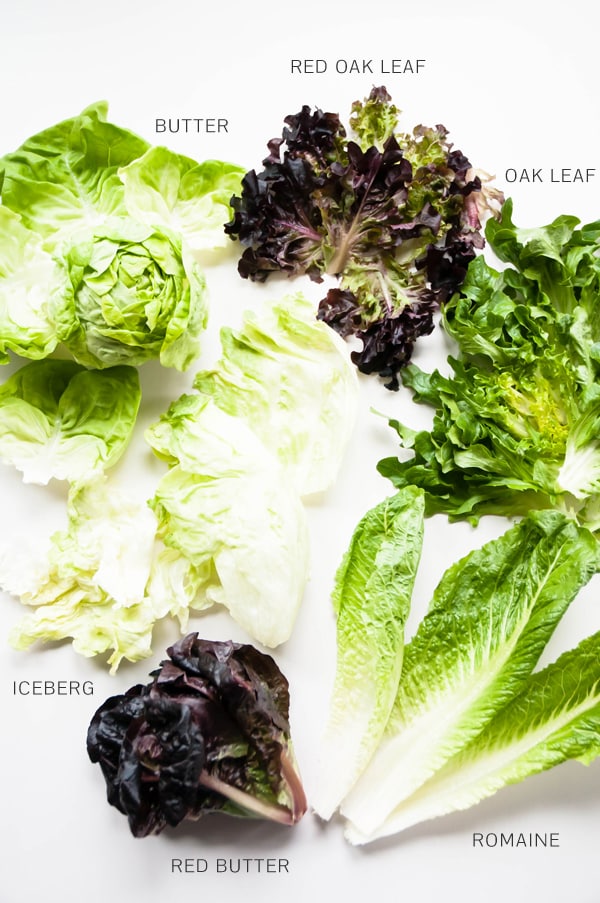
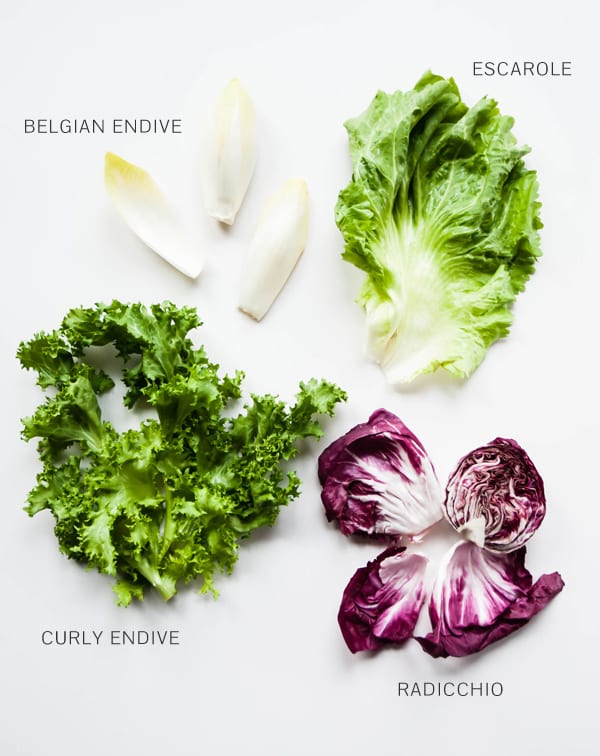
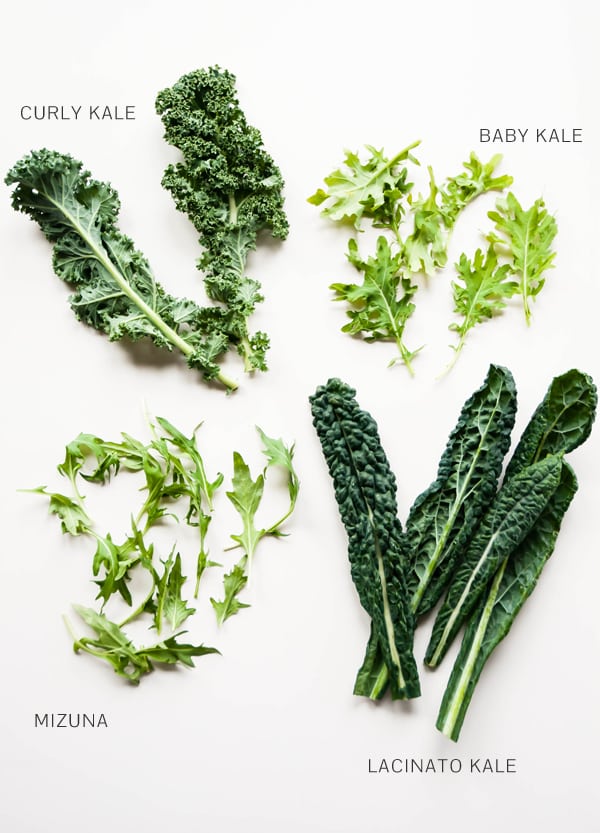
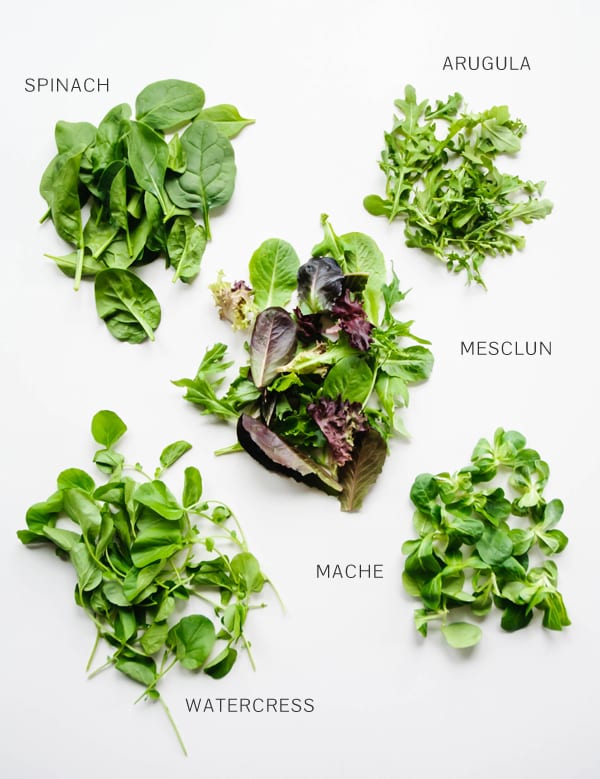
Anele @ Success Along the Weigh says
That's one heck of a list but a good one! So many pretty colors. It makes me think of my grandpa because he refuses to eat anything other than iceberg. If he saw any of these, he'd be pushing the salad away.
The only tip I can share is I store my lettuce in foil. It works best on the heartier ones (nothing limp-ish like arugula or watercress) and if I'm using a head like little gem for tuna or chicken wraps, it's still as crisp and fresh three weeks later as day one.
Kare Troughton says
Thanks so much, Anele! What a great tip about storing your lettuce in foil. Three weeks?! I can't wait to try that one!
Meg van der Kruik says
I love this guide!!! Well done and those pictures make me swoon.
Kare Troughton says
Thank you, Meg! Lindsey did a killer job on the photos, didn't she?!!
Lindsey | Cafe Johnsonia says
You are too nice, Kare! Great - no excellent - guide!
Julia says
My gosh, there are SO many greens I have yet to try! I've had tunnel vision when it comes to greens and have been sticking with the same ol' kale and spring green mix. Time for me to try out some new leaves! Mizuna?!? Bring it on!! Thanks for such a wonderful guide, Kare! 😀
Kare Troughton says
Mizuna is new to me, too! I know, I inspired myself to get way more leafy greens into my diet. Bring on the green salads! 🙂
Emily @ Zen & Spice says
Great guide!! Very thorough. I've never heard of mache or mesclun. I'll have to look for them the next time I'm at the store.
Phi @ The Sweetphi Blog says
LOVE LOVE LOVE this post! What beautiful photos and wonderful information. I totally cracked up about your description of the girl ... alone... smiling with a giant salad bowl, I totally know what you're talking about and agree 🙂
janet @ the taste space says
Good reminder how to rotate my greens. Thank you for linking to one of my recipes. 🙂
Alexandra @ Made to Glow says
I love this! What an awesome, comprehensive resource for getting your salad on. Beautiful pics and lots of valuable info, thank you!
Isadora says
Wow! This is so helpful! I never realized how many different types of greens there are out there, sadly, most of which I have never tried. I just planted a mesclun mix in my garden and I've been having fun seeing what pops up! I will be saving this post and trying to cross off as many different types of salad greens as I can this summer!
Kare Troughton says
I love that - The Summer Salad Green Challenge - cross as many off the list as you can. I think I will join you! 🙂 Best of luck on the garden - they are so fun!
Laura (Tutti Dolci) says
Gorgeous guide and I love all the recipe suggestions!
Emma says
This is such a great resource. I was marveling at all the different salad greens at the farmers' market on Saturday. I'm currently all about the mache and rocket (arugula)! Pinning this for future reference and recipe ideas 🙂
Lindsey @ American Heritage Cooking says
Wow! That is the most wonderful, informative post I have seen on the different varieties of salad greens! I LOVE mache but haven't been able to find in in the States except for in a mix at Whole Foods and there are only 4 in the whole container!! One of the foods I miss most about France!
Joanne says
It's probably sad how little i know about these greens that I eat so often! I feel so educated now!
Alley @ Alley's Recipe Book says
Have you read the book Taste of Tomorrow? There is a whole chapter about the American transition from iceberg to bagged lettuce and looked at what the next salad trend might be (specifically looking into radicchio). Any way, great post!
Kare Troughton says
I haven't, but now it's on my list!
kp says
Found your site today and very much like the overall appearance and style. Just when I thought I knew all about salad greens you introduce me to some I have never heard of. Can't wait to incorporate them into my diet. The pictures are simply beautiful and make want to take a bit out of them:) I eat and drink greens everyday. Can't wait to try out the new ones!
Allison @ Clean Wellness says
Wow! This is so comprehensive. I'm going to share this 🙂
Kare Troughton says
Thank you for the shares!
Caitlin says
Thank you for this post! I work with a school garden that recently planted many of these salad greens, and I linked this guide on our blog post (http://dexterfarmtoschool.org/2014/04/23/student-grown-salad-greens-soon/). It will be a great guide for our Foods Lab teacher and kitchen staff to reference when making fresh salads with the greens students grow in the garden.
Kare Troughton says
What a wonderful school project! So glad you found it useful.
Manasee says
I am entering the world of SALADS and this article is really helpful. There are so many options out there and it is so hard to understand it all without any reference. thank you very much for sharing the info.
Gem says
This is so informative! And I love the recommended recipe links under each type of salad 😉
I usually stick to spinach and baby kale, but am stoked to try out the others based on the recipes now.
KAY M says
I LOVE GREEN GIANT VEGGIES AND SALAD GREENS -- BUT -BECAUSE OF THE E COLI CONTAMINATION---- I NEED TO KNOW WHERE GREEN GIANT SALAD IS GROWN SO I DO NOT MAKE MY FAMILY SICK LOOKING FORWARD TO A REPLY CLARIFYING THE SOURCE ------ sincerely KAY M
sweet potato says
Great guide!! Very thorough. I’ve never heard of mache or mesclun. I’ll have to look for them the next time I’m at the store.
TONY says
Wow! That is the most wonderful, informative post I have seen on the different varieties of salad greens! I LOVE mache but haven’t been able to find in in the States except for in a mix at Whole Foods and there are only 4 in the whole container!! One of the foods I miss most about France!